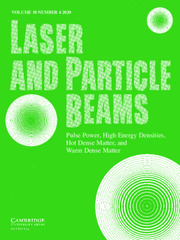Crossref Citations
This article has been cited by the following publications. This list is generated based on data provided by
Crossref.
Frolov, Oleksandr
Kolacek, Karel
Schmidt, Jiri
Straus, Jaroslav
Prukner, Vaclav
and
Choukourov, Andrei
2012.
Non-thermal surface modification of solids induced by EUV laser pulses.
p.
1P-166.
Sobhani, Maliheh
and
Mahdieh, Mohammad Hossein
2013.
Comparison of sub-micro/nano structure formation on polished silicon surface irradiated by nanosecond laser beam in ambient air and distilled water.
Laser and Particle Beams,
Vol. 31,
Issue. 3,
p.
465.
Assoufid, Lahsen
Ohashi, Haruhiko
Asundi, Anand K.
Kolacek, K.
Schmidt, J.
Straus, J.
Frolov, O.
Prukner, V.
and
Melich, R.
2014.
An extreme ultraviolet interferometer suitable to generate dense interference pattern.
Vol. 9206,
Issue. ,
p.
92060D.
Frolov, Oleksandr
Kolacek, Karel
Schmidt, Jiri
and
Straus, Jaroslav
2014.
EUV radiation from nitrogen capillary discharge.
International Journal of Modern Physics: Conference Series,
Vol. 32,
Issue. ,
p.
1460329.
Klisnick, Annie
Menoni, Carmen S.
Schmidt, Jiri
Kolacek, Karel
Frolov, Oleksandr
Straus, Jaroslav
and
Choukourov, Andrei
2015.
Soft x-ray source based on the high-current capillary-discharge system.
Vol. 9589,
Issue. ,
p.
958911.
Kolacek, K.
Schmidt, J.
Straus, J.
Frolov, O.
Prukner, V.
Melich, R.
and
Psota, P.
2016.
Spontaneous and artificial direct nanostructuring of solid surface by extreme ultraviolet laser with nanosecond pulses.
Laser and Particle Beams,
Vol. 34,
Issue. 1,
p.
11.
Frolov, O.
Kolacek, K.
Schmidt, J.
and
Straus, J.
2016.
X-Ray Lasers 2014.
Vol. 169,
Issue. ,
p.
397.
Cui, Huaiyu
Zhang, Shuqing
Li, Jingjun
Lu, Haiqiang
and
Zhao, Yongpeng
2017.
Craters and nanostructures on BaF2 sample induced by a focused 46.9nm laser.
AIP Advances,
Vol. 7,
Issue. 8,
Zhao, Yongpeng
Cui, Huaiyu
Zhang, Shuqing
Zhang, Wenhong
and
Li, Wei
2017.
Formation of nanostructures induced by capillary-discharge soft X-ray laser on BaF2 surfaces.
Applied Surface Science,
Vol. 396,
Issue. ,
p.
1201.
Straus, Jaroslav
Kolacek, Karel
Schmidt, Jiri
Frolov, Oleksandr
Vilemova, Monika
Matejicek, Jiri
Jager, Ales
Juha, Libor
Toufarova, Martina
Choukourov, Andrey
and
Kasuya, Koichi
2018.
Response of fusion plasma-facing materials to nanosecond pulses of extreme ultraviolet radiation.
Laser and Particle Beams,
Vol. 36,
Issue. 3,
p.
293.
Frolov, O.
Kolacek, K.
Schmidt, J.
Straus, J.
Choukourov, A.
and
Pira, P.
2018.
X-Ray Lasers 2016.
Vol. 202,
Issue. ,
p.
327.
Nigam, Sameer
Barnwal, Shreekant
Kodakkat, Aneesh
Sharma, Manohar L.
Prasad, Yelchuri B. S. R.
Tripathi, Pramod Kumar
Chakera, Juzer Ali
and
Naik, Prasad Anant
2019.
A Compact Pulse Power System for Capillary Discharge Plasma-Based Soft X-Ray Laser.
IEEE Transactions on Plasma Science,
Vol. 47,
Issue. 5,
p.
2696.
Frolov, Alexandr
Kolacek, Karel
Schmidt, Jiri
Straus, Jaroslav
Choukourov, Andrei
Juha, Libor
Bajt, Saša
and
Guizard, Stéphane
2019.
Nanostructuring of PMMA, GaAs, SiC and Si samples by focused XUV laser beam.
p.
19.
Wang, Jinshi
Fang, Fengzhou
An, Haojie
Wu, Shan
Qi, Huimin
Cai, Yuexuan
and
Guo, Guanyu
2023.
Laser machining fundamentals: micro, nano, atomic and close-to-atomic scales.
International Journal of Extreme Manufacturing,
Vol. 5,
Issue. 1,
p.
012005.
An, Haojie
Wang, Jinshi
Cui, Huaiyu
and
Fang, Fengzhou
2023.
Periodic surface structure of 4H-SiC by 46.9 nm laser.
Optics Express,
Vol. 31,
Issue. 10,
p.
15438.

